Recently a college friend of mine sent around this article, written by a fellow alumnae, author J. Courtney Sullivan.
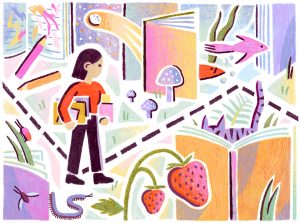
The article focused on Sullivan’s quest to rebuild her childhood book collection as an adult, and the memories that each of those books held for her now. Some were of reading with her dad:
When I received the “Stickybear” books by Richard Hefter and saw the familiar endpapers covered in strawberries, I recalled how my dad would read the strawberries as part of the text. Example: “The end. Strawberry strawberry strawberry strawberry strawberry.”
While others helped her realize how differently younger readers absorb and learn to love literature:
Childhood is where a love of reading is forged through the tactile. The stories themselves matter, of course. Sometimes I think about Beverly Cleary’s “Ramona,” with her tubes of toothpaste, her bites of apple. Nothing I’ve read since, no single image, stands out as these do. But in adulthood, it’s always the text I admire. In childhood, the book as object matters most.
It’s a lovely article, and the quest itself upon which Sullivan embarks may be familiar to many of you–she notes that a number of book sellers with whom she dealt were curious about all the early-to-mid 1980’s picture books that were suddenly enjoying a resurgence in popularity.
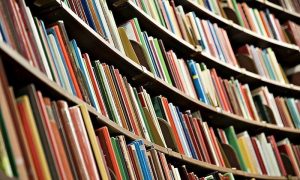 And, of course, it got me thinking about the books that defined my own childhood. I realized, pretty quickly, that most of the books that defined my growing-up years were ones that I shared with others–usually, they were books read to my by my Father, or my teachers, or books that I learned to read myself (see below). I always had trouble as a kid with the thin line between fiction and reality (I still do, let’s be honest here), and it was (is) a source of constant frustration for me that I was the only person who knew the members of the Baby-Sitters’ Club, or who had wandered around Gormenghast castle with Steerpike, or bought fancy shoes with Polly from An Old Fashioned Girl (let it not be said that I didn’t have eclectic tastes as a young-in’!). So in picking books that were important to me, I realized that I was also picking moments in my childhood that were significant, or people, or places.
And, of course, it got me thinking about the books that defined my own childhood. I realized, pretty quickly, that most of the books that defined my growing-up years were ones that I shared with others–usually, they were books read to my by my Father, or my teachers, or books that I learned to read myself (see below). I always had trouble as a kid with the thin line between fiction and reality (I still do, let’s be honest here), and it was (is) a source of constant frustration for me that I was the only person who knew the members of the Baby-Sitters’ Club, or who had wandered around Gormenghast castle with Steerpike, or bought fancy shoes with Polly from An Old Fashioned Girl (let it not be said that I didn’t have eclectic tastes as a young-in’!). So in picking books that were important to me, I realized that I was also picking moments in my childhood that were significant, or people, or places.
In that sense, nothing has changed for me. Some of my favorite literary memories are from reading specific books in specific places (I first read ‘Salem’s Lot in the Belfast Botanical Gardens, and Oscar and Lucinda in Harvard Square one blustery autumn week). And the specific people with whom I shared them. So here are some of the first titles that leapt to my mind upon reading Sullivan’s article:
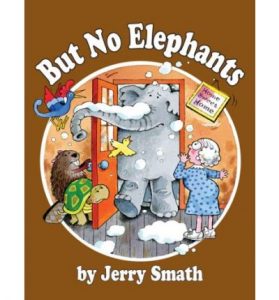 But No Elephants: For some reason, I was obsessed with this book as a little kid, and made my parents read the adventures of Grandma Tildy and her willingness to take any animal–except for pachyderms–so often that by the time I was about two, I had the whole book memorized, including when to turn the pages. It then became my parents’ favorite parlor trick to set me up on the couch when company was over and tell them I could already read. I rediscovered this book when I was a bit older, and still found plenty to appreciate here–especially the brave little(ish) elephant who proves his worth to his new family when Grandma Tildy finally relents enough to take him in.
But No Elephants: For some reason, I was obsessed with this book as a little kid, and made my parents read the adventures of Grandma Tildy and her willingness to take any animal–except for pachyderms–so often that by the time I was about two, I had the whole book memorized, including when to turn the pages. It then became my parents’ favorite parlor trick to set me up on the couch when company was over and tell them I could already read. I rediscovered this book when I was a bit older, and still found plenty to appreciate here–especially the brave little(ish) elephant who proves his worth to his new family when Grandma Tildy finally relents enough to take him in.
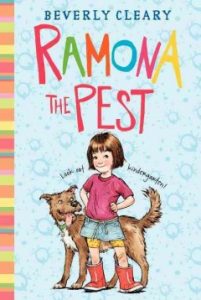 Ramona the Pest: My second grade teacher was so good at reading stories out loud that we would do any math exercise, any spelling test voluntarily in order to make time for reading at the end of the day. We made it through most of Beverly Cleary’s Ramona books by the end of the year, but this one I remember most vividly because, in it, Ramona learns how to tell time. Or learns that she doesn’t know how to tell time. And it wasn’t until that scene that I realized that I didn’t know how to properly tell time either! Digital clocks were just becoming a think (I’m old, I know, it’s fine), and so I had been able to avoid analog time-telling up to this point. It’s a rare day when I put on my watch that I don’t think fleetingly of Ramona heading off to school, and of my teacher who brought her stories to life for us. (Note: this was absolutely not the cover of the book we had. Our class book was printed in the 1960’s, so I think it was avocado green or something….)
Ramona the Pest: My second grade teacher was so good at reading stories out loud that we would do any math exercise, any spelling test voluntarily in order to make time for reading at the end of the day. We made it through most of Beverly Cleary’s Ramona books by the end of the year, but this one I remember most vividly because, in it, Ramona learns how to tell time. Or learns that she doesn’t know how to tell time. And it wasn’t until that scene that I realized that I didn’t know how to properly tell time either! Digital clocks were just becoming a think (I’m old, I know, it’s fine), and so I had been able to avoid analog time-telling up to this point. It’s a rare day when I put on my watch that I don’t think fleetingly of Ramona heading off to school, and of my teacher who brought her stories to life for us. (Note: this was absolutely not the cover of the book we had. Our class book was printed in the 1960’s, so I think it was avocado green or something….)
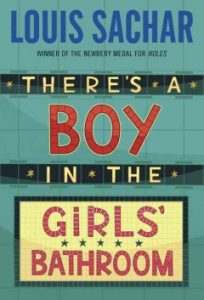 There’s A Boy in the Girl’s Bathroom: I’ve told about my love of Louis Sachar’s wild imagination a few times before. But this book was the first “realistic” one that I read. Or, specifically, that my Father read to me. We had a nighttime reading ritual of a chapter a night, and I loved this book…right up until the last chapter. Essentially, the main character, a boy who everyone considers ‘unmanageable’, has quite the imagination, and creates beautiful, elaborate stories with his figurine collection. He finds the courage and tools to begin socializing with his peers after working with his school’s counselor. And he sends her a gift in the end. And because my imagination was as good, if not more tenacious than his, I cared way more about his figurines than his actual friends. And I lost it. Ugly crying everywhere. Luckily, I have a Father who gets it, and he and I set about re-writing the ending to the book, so that, in our world, at least, it ended properly. And it’s a trick I’ve used to endure books with “bad” endings ever since (and here, “bad” is defined absolutely, positively subjectively).
There’s A Boy in the Girl’s Bathroom: I’ve told about my love of Louis Sachar’s wild imagination a few times before. But this book was the first “realistic” one that I read. Or, specifically, that my Father read to me. We had a nighttime reading ritual of a chapter a night, and I loved this book…right up until the last chapter. Essentially, the main character, a boy who everyone considers ‘unmanageable’, has quite the imagination, and creates beautiful, elaborate stories with his figurine collection. He finds the courage and tools to begin socializing with his peers after working with his school’s counselor. And he sends her a gift in the end. And because my imagination was as good, if not more tenacious than his, I cared way more about his figurines than his actual friends. And I lost it. Ugly crying everywhere. Luckily, I have a Father who gets it, and he and I set about re-writing the ending to the book, so that, in our world, at least, it ended properly. And it’s a trick I’ve used to endure books with “bad” endings ever since (and here, “bad” is defined absolutely, positively subjectively).
How about you? What books, moments, places, and people make up your early literary history?
